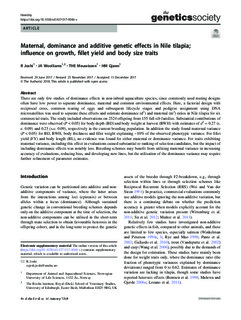| dc.contributor.author | Joshi, Rajesh | |
| dc.contributor.author | Woolliams, John Arthur | |
| dc.contributor.author | Meuwissen, Theo | |
| dc.contributor.author | Gjøen, Hans Magnus | |
| dc.date.accessioned | 2018-05-03T08:20:39Z | |
| dc.date.available | 2018-05-03T08:20:39Z | |
| dc.date.created | 2018-02-26T10:15:53Z | |
| dc.date.issued | 2018 | |
| dc.identifier.citation | Heredity. 2018, . | nb_NO |
| dc.identifier.issn | 0018-067X | |
| dc.identifier.uri | http://hdl.handle.net/11250/2496898 | |
| dc.description.abstract | There are only few studies of dominance effects in non-inbred aquaculture species, since commonly used mating designs often have low power to separate dominance, maternal and common environmental effects. Here, a factorial design with reciprocal cross, common rearing of eggs and subsequent lifecycle stages and pedigree assignment using DNA microsatellites was used to separate these effects and estimate dominance (d2) and maternal (m2) ratios in Nile tilapia for six commercial traits. The study included observations on 2524 offspring from 155 full-sib families. Substantial contributions of dominance were observed (P < 0.05) for body depth (BD) and body weight at harvest (BWH) with estimates of d2 = 0.27 (s.e. 0.09) and 0.23 (s.e. 0.09), respectively in the current breeding population. In addition the study found maternal variance (P < 0.05) for BD, BWH, body thickness and fillet weight explaining ~10% of the observed phenotypic variance. For fillet yield (FY) and body length (BL), no evidence was found for either maternal or dominance variance. For traits exhibiting maternal variance, including this effect in evaluations caused substantial re-ranking of selection candidates, but the impact of including dominance effects was notably less. Breeding schemes may benefit from utilising maternal variance in increasing accuracy of evaluations, reducing bias, and developing new lines, but the utilisation of the dominance variance may require further refinement of parameter estimates. | |
| dc.language.iso | eng | nb_NO |
| dc.relation.uri | https://www.nature.com/articles/s41437-017-0046-x | |
| dc.rights | Attribution-NonCommercial-NoDerivatives 4.0 Internasjonal | * |
| dc.rights.uri | http://creativecommons.org/licenses/by-nc-nd/4.0/deed.no | * |
| dc.title | Maternal, dominance and additive genetic effects in Nile tilapia; influence on growth, fillet yield and body size traits | nb_NO |
| dc.type | Journal article | nb_NO |
| dc.type | Peer reviewed | nb_NO |
| dc.description.version | publishedVersion | |
| dc.source.pagenumber | 11 | nb_NO |
| dc.source.journal | Heredity | nb_NO |
| dc.identifier.doi | 10.1038/s41437-017-0046-x | |
| dc.identifier.cristin | 1568575 | |
| cristin.unitcode | 192,10,1,0 | |
| cristin.unitname | Institutt for husdyr- og akvakulturvitenskap | |
| cristin.ispublished | true | |
| cristin.fulltext | original | |
| cristin.qualitycode | 1 | |

